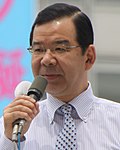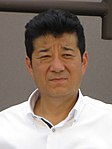Fukuoka at-large district is a constituency of the House of Councillors in the Diet of Japan. It consists of the entire prefecture of Fukuoka and is represented by four Councillors electing two per election by single non-transferable vote.
The Yamaguchi at-large district is a constituency of the House of Councillors in the Diet of Japan. It consists of the entire prefecture of Yamaguchi and is represented by two Councillors electing one every three years.
The Okinawa at-large district is a constituency of the House of Councillors in the Diet of Japan. It consists of the entire prefecture of Okinawa and was created in 1970 following the agreement between US president Richard Nixon and prime minister Eisaku Satō on restoration of Japanese sovereignty over the Ryūkyū islands. Okinawa is represented by two Councillors electing one every three years.
Tochigi at-large district is a constituency of the House of Councillors in the Diet of Japan. It consists of Tochigi Prefecture and elects two Councillors, one per election.
The Kagawa at-large district is a constituency of the House of Councillors in the Diet of Japan. It consists of Kagawa Prefecture and elects two Councillors, one every three years by a first-past-the-post system for a six-year term. In the first election in 1947, Kagawa like all districts used single non-transferable vote to elect both its Councillors in one election.
Tokushima at-large district is a constituency of the House of Councillors in the Diet of Japan. It consists of Tokushima Prefecture and elects two Councillors, one every three years by a first-past-the-post system for a six-year term. In the first election in 1947, Tokushima like all districts used single non-transferable vote to elect both its Councillors in one election.
The Nagasaki at-large district is a constituency of the House of Councillors in the Diet of Japan. It consists of Nagasaki Prefecture and elects two Councillors, one every three years by a first-past-the-post system for a six-year term. In the first election in 1947, Nagasaki like all districts used single non-transferable vote to elect both its Councillors in one election.
The Aichi at-large district is a constituency of the House of Councillors in the Diet of Japan that represents Aichi Prefecture. From 1947 until 2013 it has elected six Councillors, three every three years by single non-transferable vote (SNTV) for six-year terms. A 2015 revision of the Public Officers Election Law increased the district's representation to eight Councillors; the change began to take effect at the 2016 election, at which four Councillors were elected.
Hyogo 11th district is a constituency of the House of Representatives in the Diet of Japan. It is located in Southwestern Hyōgo and is based on the 1995 borders of the city of Himeji; the former towns of Ieshima, Yumesaki, Kōdera and Yasutomi that merged into Himeji in 2006 are part of the 12th district. As of September 2015, 387,509 eligible voters were registered in the district.
The Nagano at-large district is a multi-member constituency of the House of Councillors in the Diet of Japan. It consists of Nagano Prefecture and elects four Councillors, two every three years by single non-transferable vote (SNTV) for six-year terms.
The Iwate at-large district is a constituency of the House of Councillors in the Diet of Japan. It consists of Iwate Prefecture and elects two Councillors, one every three years, making it one of the decisive single-member districts.
Saitama at-large district is a three-member constituency of the House of Councillors, the upper house of the national Diet of Japan. It consists of Saitama and elects three Councillors for six-year terms every three years by single non-transferable vote.

Yamaguchi 4th district is a single-member electoral district for the House of Representatives, the lower house of the National Diet of Japan. It is located in Western Yamaguchi and consists of the cities of Shimonoseki and Nagato. As of September 2011, 266,456 voters were registered in the district, giving its voters well above average vote weight. Unlike many prefectures where the capital is also the most populous city, Yamaguchi's major city is Shimonoseki, located at the western tip of Honshū and part of the Fukuoka-Kitakyūshū metropolitan area.

The 24th regular election of members of the House of Councillors was held on Sunday 10 July 2016 to elect 121 of the 242 members of the House of Councillors, the upper house of the 717-member bicameral National Diet of Japan, for a term of six years. As a result of the election, the LDP/Komeito coalition gained ten seats for a total of 146, the largest coalition achieved since the size of the house was set at 242 seats.
The Hyogo at-large district is a constituency that represents Hyogo Prefecture in the House of Councillors in the Diet of Japan. It currently has five Councillors in the 242-member house, but this representation will increase to six by July 2019.
The Tottori-Shimane at-large district is a constituency of the House of Councillors in the Diet of Japan. It was formed pursuant to a 2015 revision of the Public Officers Election Law from a merger of the Tottori and Shimane at-large districts, the two smallest districts in the country, to address the imbalance in representation between rural and urban voters. The district has 1,068,348 registered voters and was contested for the first time at the House of Councillors election that was held on 10 July 2016.
The Miyagi at-large district is a constituency that represents Miyagi Prefecture in the House of Councillors in the Diet of Japan. It currently has three Councillors in the 242-member house, but this representation will decrease to two at the next election, to be held by July 2019.
The Saga at-large district is a constituency that represents Saga Prefecture in the House of Councillors in the Diet of Japan. Councillors are elected to the house by single non-transferable vote (SNTV) for six-year terms. Since the establishment of the current House of Councillors electoral system in 1947, the district has elected two Councillors, one each at elections held every three years. It has 679,289 registered voters as of September 2015.
The Niigata at-large district is a constituency that represents Niigata Prefecture in the House of Councillors in the Diet of Japan. It currently has three Councillors in the 242-member house, but this representation will decrease to two by July 2019.

















